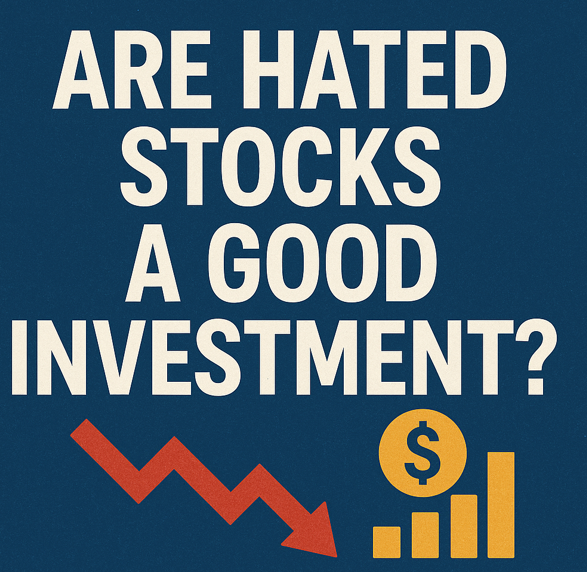Are Hated Stocks A Good Investment?
In the world of finance, professional financial analysts play an important role, directing the allocation of capital through in-depth research. When analyzing a company, analysts typically conclude their reports with a recommendation, usually categorized as strong buy, buy, hold, sell, or strong sell.
Generally, when analysts give a stock a positive recommendation, investors react positively, and when they give a negative one, investors react negatively.
Recently, some columnists have suggested a contrarian view: that the most hated stocks might actually be the best investments. A research paper called Are Hated Stocks Good Investments? investigates that surprising claim (by Jouahn Nam, Jun Wang, Cunyo Xing, and Ge Zhang).
The study concludes that hated stocks have outperformed, but that the results are unstable. For example, results varied across time periods, and the best performance was among low-priced stocks below 5 USD. The latter might give inspiration for further research (if you ask us).
What Exactly Are “Hated Stocks”?
For this study, researchers defined hated stocks as those having an average analyst recommendation level of ‘hold or worse’. This means the consensus view among analysts is generally unfavorable.
The study tracked the long-term performance of these stocks from the end of 2008 to the end of 2014, the period suggested to show strong performance for these types of stocks.
The Initial Findings
When looking exclusively at the S&P 500 stocks, the results initially supported the contrarian view.
From the beginning of 2009 to the end of 2014, the group of hated S&P 500 stocks outperformed the rest of the S&P 500. For instance, a dollar invested in hated S&P 500 stocks at the start of 2009 turned into more than four dollars by the end of 2014, while a dollar invested in the S&P 500 index itself only grew to $2.60 over the same period.
When expanding the analysis to include all stocks followed by at least five analysts, hated stocks still outperformed non-hated stocks during this time frame.
The Critical Caveats: Why the Outperformance Vanishes
While the initial results seem exciting for contrarian investors, digging deeper reveals that this outperformance is unstable and driven by two key factors.
1. The Time Period: The 2009-2010 Effect
The superior performance of hated stocks was highly dependent on the initial time period studied: 2009 and 2010. These two years immediately followed the financial crisis, a “turmoil period” when common investment strategies often did not perform well.
- If the investment strategy started at the beginning of 2011 (excluding 2009 and 2010), there was no significant outperformance of hated stocks.
- When the investment started in 2011, a dollar in hated S&P 500 stocks grew to about two dollars by the end of 2014, compared to $1.80 for the S&P 500—a much smaller difference than the previous period.
The market appears to have overreacted to analyst recommendations during this tumultuous period (2009 and 2010).
2. The Low-Priced Stock Factor
The second major driver of the performance was the inclusion of low-priced stocks – those with a market share price below $5 per share.
- If the researchers excluded these low-priced stocks from the sample, starting from 2009, there was no significant outperformance of the hated stocks.
- The exclusion of these stocks mainly impacted the years 2009 and 2010, as many stocks fell to very low prices following the market slide during the financial crisis.
For investors who tend to avoid low-priced stocks, such as institutional investors, the finding that hated stocks outperform should be treated cautiously.
Related reading: –Why Are Penny Stocks Bad? (Risks And Rewards)
What About the “Loved Stocks”?
To provide a comparison, the researchers also examined loved stocks, defined as those having a consensus recommendation of 1.5 or better (the midpoint between “strong buy” and “buy”).
As a group, loved stocks did not perform any differently from non-loved stocks in the S&P 500 sample or in the larger universe of stocks. This result suggests that there is little long-term “post recommendation drift” in the current market, meaning analysts’ positive recommendations don’t reliably translate into superior long-term stock returns.
Final Takeaway for Investors
The results suggest that, for most stocks and during regular periods, the market efficiently incorporates analyst recommendations. The overall long-term performance of stocks after an analyst recommendation remains flat.
While hated stocks may appear to offer a successful contrarian investment strategy, the outperformance is highly sensitive to the sample period and sample selection. The success of the “hated stocks” strategy was really just an indication of market overreaction that occurred in the two tumultuous years immediately following the financial crisis, or within the specific group of low-priced stocks.
Therefore, as an investment strategy, one needs to be cautious about the specific conditions under which investing in hated stocks might actually deliver abnormal returns.


